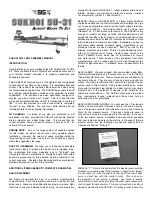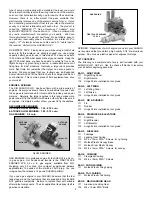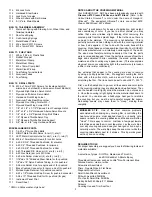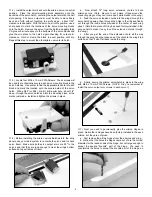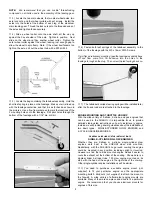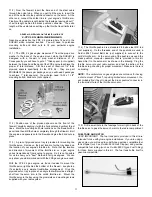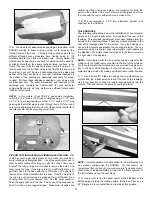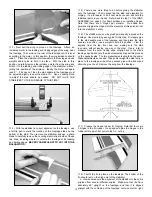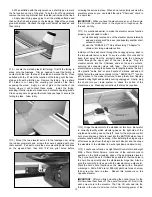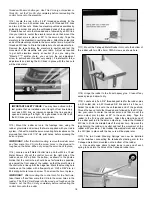
1
required to fly your SUKHOI SU-31 - rudder, elevator, ailerons, and
throttle. However, you will require a total of six servos - ailerons
(2), elevators (2), rudder (1), and throttle (1).
SERVOS: Since your SUKHOI SU31 is a large, highly aerobatic
airplane and because the control surfaces are also large, we urge
you to use appropriate servos on all the flight surfaces (ailerons,
elevator and rudder).
This model should not be flown with
"standard" 40 - 50 inch/ounce output servos! The SUKHOI is big
enough to impart very large air loads and standard servos will
quickly fail, resulting in loss of control. You should use heavy-duty
ball-bearing servos with at least 70 inch/ounces of torque or more
to drive the ailerons, elevators and rudder. If available, use a servo
with metal gears instead of plastic gears.
Specifically in our
prototype models, we used Airtronics™ #94731 servos for the
ailerons, elevators, and rudder. This is a dual ball-bearing servo,
rated at 77 inch/ounces of torque. Another good choice is the
Hitec™ #605MG servo, which has 76 inch/ounces of torque
and metal gears. These servos or their equivalent from other
manufacturers, can be relied upon to work well throughout the
SUKHOI's flight envelope. A "standard" servo is adequate for the
throttle.
SERVO ARMS: We also suggest that you consider using after-
market reinforced plastic servo output arms, such as the Du-Bro
"Super Strength" products. These output arms are available to fit
any brand of servo. They are very strong and work well with this
model. We highly recommend their use with the pull-pull rudder
system used in this SUKHOI. Using typical plastic servo output
arms with the braided steel cables for rudder control, may cause
problems due to the potential of wearing of the plastic by the
cables over extended use. The Du-Bro output arms are molded
from considerably tougher material and these have held up
extremely well in our prototypes.
SERVO EXTENSION CHORDS: You will need two 12" extension
chords and one standard Y-harness chord for the aileron servos;
one 24" extension chord for the rudder servo; and one Y-harness
chord for the elevator servos.
Y-harness chords are used to
connect two servos to a single plug-in in the receiver. In the case
of the two aileron servos, a standard Y-harness chord, available
from your radio manufacturer, will work fine. In the case of the two
elevator servos, see the following note about a special kind of
Y-harness called the "Miracle Y".
MIRACLE "Y": Note in the photos that the elevator servos will be
mounted on opposite sides of the fuselage in exact "mirror image"
to each other (i.e.; with the pushrods coming off the top of each
servo in direct line with the control horns).
This is done so
the geometry of the servos, pushrods, and horns is exactly
symmetrical on both sides, providing the exact same response to
control inputs for each elevator. This is very important in an all out
aerobatic machine like the SUKHOI. Normally in order to have this
R
SUKHOI SU-31 ARF ASSEMBLY MANUAL
INTRODUCTION:
Congratulations on your purchase of the SIG SUKHOI SU-31 ARF
kit! We're confident that this SUKHOI will quickly become one of
your favorite models, provided it is properly assembled and
adequately powered.
This SUHKOI kit features some of the lightest, best engineered
construction of any ARF on the market. It is remarkably light and
strong! This is one of the reasons it flies as well as it does, using
the recommended engine sizes. The SUKHOI has superb take-off
and landing characteristics combined with unlimited aerobatic
capabilities.
The airframe has been specifically designed to
provide you with a "zeroed out" model. This is to say that the
wings and horizontal stabilizer sit at 0
O
in relationship to the thrust
line. In turn, this provides you with a model that is completely
"honest" in any attitude.
We will cover more detailed set-up
information later in the assembly instructions.
3D CAPABLE!
For those of you who are interested in 3-D
aerobatics, we have provided the SUKHOI with double beveled
aileron, elevator and rudder hinge lines. This means that the
control surfaces can be driven to throws in excess of 45
O
for
extreme 3-D maneuvers!
ENGINE NOTE:
Due to the large number of useable engines
for this model, we simply cannot cover every possible engine
installation. However, the volume of space provided inside the
large cowling should make it easy to mount virtually any engine
within the suggested size range.
EASY TO ASSEMBLE! We urge you to follow these assembly
instructions closely to produce the model as it is intended to be.
We understand that many modelers love to "kit bash" and
incorporate their own modifications. Simply be aware that certain
assembly procedures for this airplane must be followed in the
correct sequence. Deviation from these instructions could lead to
problems beyond our control. Plan carefully!
ADDITIONAL ITEMS NEEDED TO COMPLETE THIS MODEL
RADIO EQUIPMENT
We highly recommend the use of a modern programmable
computer radio. Such radio systems allow you to easily set and
adjust every channel and additionally pre-program various flight
functions to suit your individual style of flying. Four channels are
Summary of Contents for SUKHOI SU-31 ARF
Page 23: ...23 ...

